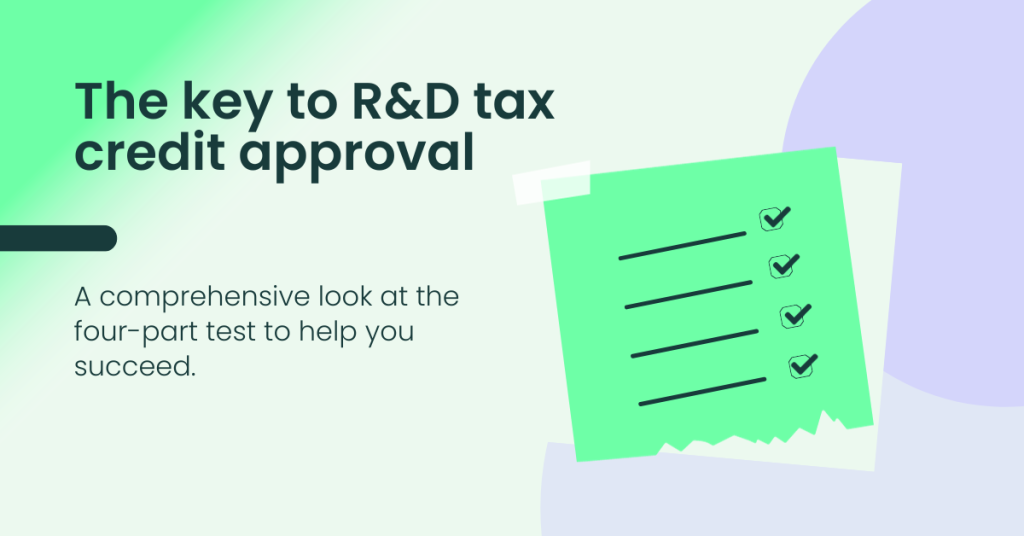4 Key Factors Determining Your Qualifying Activities for R&D Tax Credits
22 September 2023

While it’s easy to view the R&D tax credit incentive as an amazing opportunity, it’s more difficult to gauge whether you have qualifying R&D activities. So here’s the kicker: to unlock these valuable incentives, you must first pass the rigorous four-part test. Don’t worry, though – in this comprehensive guide, we’ll demystify the R&D tax credit four-part test, making it easier than ever for you to access your qualifying R&D endeavours to uplift the financial rewards your innovation deserves.
What counts as R&D?
The specific projects and business operations that are directly related to research and development are consequently eligible for R&D tax relief; a Governmental incentive with the purpose of financially supporting R&D initiatives across the United Kingdom. By receiving R&D tax credits, businesses can continue to invest in their endeavours, supporting the transformations of various industries. HMRC has criteria of what counts as R&D, and therefore which qualifying costs can be offset.
What is the four-part test (four criteria) for R&D tax relief?
The four-criteria test is a framework used to determine research and development (R&D) activities for businesses. Complying with this four-part test allows businesses to potentially access tax incentives that can significantly offset the costs of innovation, ultimately fostering growth and competitiveness in the market. However, it’s crucial to stay updated on the specific regulations and guidelines related to R&D tax relief, as they can change over time. Consulting with R&D tax credit specialists such as ourselves is advisable to navigate this complex landscape effectively. Let’s walk you through these four criteria one by one.
1. What is the permitted purpose?
Do your projects have the aim of enhancing the performance, reliability, quality and functionality of a product or software? Could a professional in the field solve the uncertainty right now? You are eligible for R&D if you are improving something that already exists, such as increasing the protein content of a recipe or adding a robotic arm to an existing manufacturing process to increase speed. Your project must aim to create an advance in the overall field for the betterment of society, the economy, or for people and businesses’ needs.
2. What is technological uncertainty?
At any point in your project, was there a possibility of unpredictable results arising in any of your processes? The eligible projects entail working without one clear answer in sight, and therefore there’s even the chance the project could be unsuccessful. By technical uncertainty, we mean when you know something could be possible scientifically or even technologically feasible but what is unclear is how you go about achieving the project.
3. What is the process of experimentation?
Are you engaged in the process of undertaking a trial-and-error phase with the intention of overcoming technological uncertainties? Basically, this underscores the need for a systematic and structured approach to testing and refining solutions to overcome uncertainties to be able to bring innovation. To be eligible, it can’t be publicly known how to achieve your project’s aim. When you complete your R&D claim, you’ll need to describe what methods you used as part of your process of experimentation.
4. What is technological in nature?
Do your projects fall within the domains of engineering, physical sciences, biological sciences, or computer science? R&D endeavours encompass efforts or undertakings that centre on generating a degree of enhancement or progress. These undertakings are not standard procedures and need to encompass an aspect of difficulty, where the resolution or remedy isn’t apparent or readily attainable. Progress in science or technology denotes a stride forward in comprehensive understanding or capability within a specific realm of science or technology.
Examples of R&D projects in different sectors
The R&D incentive is such an invaluable opportunity because of the broad eligibility criteria in the R&D tax credit four-part test. The key characteristic of these qualifying R&D activities is the pursuit of improvement or advancement beyond routine practices, often involving challenges that don’t have obvious solutions. The examples of these activities are presented below for more clarity.
New product development
- Designing and developing a novel consumer electronic device with improved features
- Creating a new pharmaceutical drug with enhanced efficacy and fewer side effects
- Producing a vegan version of an existing food product
Process improvement
- Developing more efficient manufacturing methods for a specific product
- Designing a streamlined supply chain process to reduce production time and costs
Software innovation
- Developing a sophisticated algorithm for real-time language translation
- Creating cutting-edge video editing software with advanced AI-driven features
Environmental advancements
- Designing a new solar panel technology that improves energy efficiency
- Developing a wastewater treatment process that reduces pollution and conserves resources
Biotechnological innovations
- Engineering genetically modified crops with increased resistance to pests and adverse conditions
- Creating new methods for tissue engineering and regenerative medicine
Healthcare breakthroughs
- Researching and developing a medical device that can diagnose diseases earlier and more accurately
- Discovering a novel treatment method for a previously untreatable medical condition
Aerospace and engineering
- Developing a lightweight material that enhances fuel efficiency in aircraft
- Designing a new type of propulsion system for space exploration
Renewable energy research
- Investigating more effective ways to store energy from renewable sources like wind and solar
- Developing advanced battery technologies for electric vehicles with longer range
Data analysis and Artificial Intelligence (AI)
- Creating machine learning algorithms that can predict consumer behaviour with higher accuracy
- Developing AI-driven tools for personalized healthcare recommendations based on individual genetic data
Exploration of new materials
- Researching and developing materials with superior strength and durability for construction
- Investigating the properties of nanomaterials for potential breakthrough applications
For more examples of qualifying R&D activities, explore our blog encompassing the direct and indirect activities within the R&D domain.
What doesn’t count as R&D?
When exploring which activities qualify for R&D tax relief, it’s equally important to grasp what lies beyond the boundaries of R&D endeavours. You can’t claim for R&D if your advance is in:
- The arts
- Humanities
- Social sciences, including economics
Activities that don’t directly aid in addressing scientific or technological uncertainty are:
- The assortment of business and monetary measures required for innovation
- The efforts aimed at enhancing non-scientific or non-technological facets of a novel or significantly enhanced process, material, device, product, or service
- The product manufacturing costs and distribution of services
- Business management and supplementary services
- Storage
- Security
- Maintenance
If you are unsure whether your work qualifies as R&D, please contact us and our specialists will be able to help.
Takeaways
In conclusion, a clear understanding of the R&D tax credit four-part test is crucial for organisations aiming to drive innovation and make meaningful advancements in the realms of science and technology. These activities encompass a wide spectrum of projects, ranging from pioneering product development to cutting-edge research in diverse fields. By engaging in such endeavours, businesses and researchers contribute not only to their own growth but also to the overall progress of human knowledge and capability, all while capitalising on R&D tax relief.







